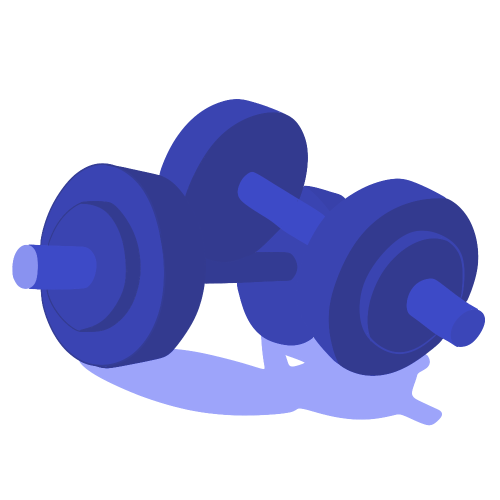For many athletes, the pressure of sport can impact their body image
Words by Ben Okazawa
Visuals by Vanessa Kauk
CONTENT WARNING: This story contains vivid descriptions of eating disorders.
Ben Steiner has been an athlete his entire life. Originally from Vancouver and a fourth-year sport media student, he was skiing before he could walk. At the age of one, he found himself propped up between his grandfather’s knees as they soared down frosty hills together. He’s competed in high-level soccer and ball hockey for years as well. In doing so, he built his body to be strong enough to endure the sports he played. He trained himself to withstand extreme elements as he zipped on skis down a snow-covered mountain at about 100 kilometres per hour and adapted to the demanding physical nature of ball hockey and soccer.
In early 2017, Steiner was the picture of health. He had just won a provincial silver medal in skiing and was training for a half-marathon in late June. To prepare, he exercised daily and ate meticulously-measured meals. Steiner remembers being excited as he started to see results, noticing how he was getting progressively leaner. His run speeds and what he saw in the mirror encouraged him to continue eating less and exercising more.
But his positive physical results didn’t tell the full story. Silently, Steiner was dismantling himself.
By summer of that same year, there were no more daily runs and no more counting every calorie he put in his body. Instead, Steiner sat propped up in a nondescript white hospital bed, the sleeves of a plain gray shirt dwarfing his arms, with paper bracelets—one blue and one red—dangling off of his wrists. Confined to the hospital and being treated for anorexia nervosa, Steiner didn’t have a run or a sport to train for. Yet, he still found himself analyzing his body in the mirror as he climbed out of his bed and trudged to the bathroom. Even then, hooked up to heart monitors and under the 24-hour watch of healthcare professionals, he thought about how he could still stand to lose weight, still pinching his sides as if attempting to rip the remaining fat right off of his own body.

For Steiner, when he was in the hospital, it was no longer about trying to run faster or train harder. He knew wanting to lose weight “logically made no sense,” he says.
But it was still on his mind. “You always want more. It’s an addicting experience.”
After spending ten days in the hospital, Steiner was released, but was not free. He was to report back for check-ups twice a week through the school year to monitor his health. After toeing the line to starvation once again, Steiner’s exhaustion got the best of him in September 2018 and he was sent back to the hospital where he remained for a hard, drawn-out seven days.
Many athletes at Toronto Metropolitan University (TMU) often feel pressure to change their bodies in order to succeed in their sport. Some push themselves to become leaner and quicker so they can get to the ball or puck faster. Others work to become bigger and stronger so they can lift more weight or overpower opponents. However, while gaining or losing weight may improve athletic performance, it can also be damaging to athletes’ body image and health.
A 2019 survey conducted by the University of Toronto found that 21 per cent of current and former Olympians reported having eating disorders. That’s well above the national average, which CAMH reports is between two to three per cent.
Aryel Maharaj is the outreach and education coordinator for the National Eating Disorder Information Centre (NEDIC). As an organizer of education and training programs about eating disorders, Maharaj has seen plenty of intersection between body image issues and sports. He says that although some people might think athletes are largely untouched by body image issues, the toxic masculinity fostered by sport and the way bodies are intertwined with athletic success can incite such harms.
“Eating disorders are as diverse as the people they can affect,” he says. “[Athletes] are preoccupied with [their body] because it’s also part of their performance.”
For women athletes, they face mounting pressures to look a certain way. In a 2017 study conducted by ESPNW, 70 per cent of surveyed female student athletes reported to be afraid of becoming “too muscular.”
Students athletes say the pressures to look and perform in certain ways can often create unhealthy relationships with their bodies

ith the punchy bass and heavy synths of EDM still blasting in her earbuds, Lynne Holloway looks past the racks of colour-coded weighted plates and at herself in one of the countless mirrors in the Mattamy Athletic Centre gym.
It’s around 7 a.m. and the fourth-year fashion production student has just finished bench pressing as part of her upper body workout for the day. Holloway wears plain-coloured leggings and an athletic top that details her muscular build. After showing up before sunrise, she’s all but alone in the gym.
Holloway analyses herself in the mirror—she likes her body. She likes what she can do with heavy weights in her hands and the extent to which she can push herself. She’s been part of TMU’s barbell club for a year now but her exercise journey started nearly a decade ago in her local CrossFit gym.
The gym is her haven. It’s where, surrounded by dumbbells, cable stacks and big, grunting men, she’s the most confident in the way she looks.
“When you train pretty seriously, watching what your body is capable of gives you a sense of confidence,” says Holloway. “So when I’m at the gym, I’m very comfortable being super muscular.”
However, there are settings where that’s not the case. Holloway finds that the performance and aesthetic expectations for women in power-lifting and other strength-based sports contradict societal expectations for female beauty.
When going out for an evening, dressing up or wearing a dress and going on a date, Holloway says that muscular women can often feel out of place.
“It’s this weird sense of duality. I wish I could hide my muscles.”
According to a 2017 study by Eating and Weight Disorders, women are also disproportionately affected by unhealthy eating habits. The journal reported that women make up approximately 84 per cent of surveyed hospital patients with eating disorders, a discrepancy that is largely credited to women having a heightened level of body distortion.

Many women with athletic bodies can sometimes find it hard to not only see themselves represented in mainstream fashion, but even struggle when shopping for new clothes. Henry Navarro Delgado, an associate fashion professor at TMU, explains that the unique distribution of many athletes’ body mass can make it extremely difficult for both male and female athletes to find properly-fitting clothing.
“You have this compounding effect,” says Delgado. “The lack of representation in magazines is important but what’s most important is the lack of choice. How can [muscular people] participate in fashion if their needs are not taken into account?”
Holloway believes that the societal expectations for how women should look are direct contributors to unhealthy eating habits and body image issues. She aims to defy those expectations and go against the norm in her capstone project this year. Her goal is to help muscular women feel confident no matter what they wear.
Holloway’s vision for her clothing collection is grand, yet humble at the same time. She pictures muscular people confidently strutting down a runway in her see-through, frilled and ruffled designs. Yet at the end of the day, the collection is less about the appearance of the clothes themselves. Instead, it’s more about the philosophy behind them. With these designs, Holloway says she wants to destigmatize the way muscular people—women in particular—are expected to dress. She wants to move away from the notion that they can only wear athleisure clothing and look good in fitness settings.
“Especially in high fashion, you don’t see [muscular bodies],” Holloway says. “My collection…is deconstructing the norms around muscles and body image.”

he road to recovery for Steiner included help from his grandmother. When he was staying with her in the summer of 2017, she noticed the severity of what he was going through in a way that nobody else had.
Her grandson was irritable; he wasn’t eating well and when he did, his meals were measured obsessively down to the last calorie. She called the NEDIC seeking information and advice just days after her grandson’s arrival at her residence on Hornby Island, which is just off the coast of Vancouver Island.
In Maharaj’s experiences with assisting people trying to learn or find resources to support their loved ones, he has found that a lack of willingness to divulge eating disorders and body image issues only further perpetuates their harm. The support of loved ones is key in the treatment of and recovery from eating disorders, he says, estimating that a quarter-to-a-third of the people making use of the NEDIC helpline are friends or family of the person affected.
Like many who’ve been in his position, Steiner initially refused to admit that he had a problem—something he attributes to the toxic masculinity embedded in sport culture.
“There’s that tough boy attitude,” he says. “Nobody wants to admit that they’re injured, let alone that they’ve got something wrong mentally.”
In Steiner’s experience, he found that some healthcare workers were so unused to treating men for eating disorders that a lack of consideration for his treatment was sometimes evident.
He realized this himself during his hospital stay, when doctors and nurses asked him if he had skipped his period as they defaulted to reading questions off of a routine symptoms list.
In addition to the healthcare improvements that Steiner thinks can be made, he also believes that key figures in athletes’ lives, such as coaches and administrators, can make a big difference in support of student athletes who struggle with body image issues or eating disorders.
The Canadian Centre for Ethics in Sport (CCES) runs a program called BodySense that aims to do just that. Their platform educates athletes about body image issues and offers those affected by them additional support. Partnered with the NEDIC, BodySense has constructed a model for support and healthy eating, which is built around promoting good habits that sports organizations of all levels can follow in order to cultivate body positivity and healthy eating habits.
BodySense specifies their support to the world of sport in their aim to destigmatize athletes’ bodies. Their website states that external pressure from the media, coaches and peers can influence body image distortion in athletes.
Today, Steiner is in a much better place. This August, he stood shirtless on top of a rock that he and his friend found in the wilderness of Lynn Valley in North Vancouver. From the top, he looked down at the eight foot drop into the blue-green water below him.
Ever the athlete, he didn’t consider the jump for long before he plunged from the edge towards the little pool of water beneath him.
“During the summer, I was in the best shape I’ve ever felt,” says Steiner, now five years removed from his first stay in the hospital.
He remembers being 16 years old and watching Denis Shapovalov explode to a Rogers Cup semi-final in an unforgettable run that included an upset over first-ranked Rafael Nadal.
It helped, in a way, to distract him from the beeping monitors, the paper bracelets and the nurses that had become his wardens.
Now, he doesn’t need a distraction. He’s traded sitting in a hospital bed for cliff-diving adventures, substituted his loose-fitting grey shirt and wristbands for a bathing suit and above all else, he’s confident in how he looks.
“[Now], I can do the things I like to do and my body’s trying to keep [up with] those things,” says Steiner. “And at the end of the day, [that’s] the most important thing.”
If you or a loved one are suffering from an eating disorder and need help, NEDIC’s help line is available at 1-866-633-420 or 416-340-4156










Leave a Reply